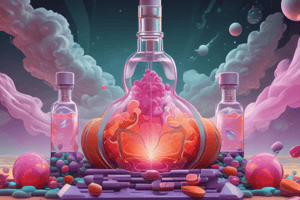Podcast
Questions and Answers
What is bioavailability?
What is bioavailability?
Percentage of a drug absorbed into systemic circulation for activity.
Define half-life of a drug.
Define half-life of a drug.
The time interval for the body’s elimination process to reduce the concentration of the drug in the body by half.
What is the significance of the peak concentration level of a drug?
What is the significance of the peak concentration level of a drug?
Most of the drug reaches the site of action and provides the therapeutic response.
Explain the term 'Duration of action' of a drug.
Explain the term 'Duration of action' of a drug.
What is the primary focus of controlled substances Schedule I?
What is the primary focus of controlled substances Schedule I?
What assessments are necessary for drug administration?
What assessments are necessary for drug administration?
What is the definition of half-life of a drug?
What is the definition of half-life of a drug?
How do physiologic changes associated with aging influence medication effectiveness?
How do physiologic changes associated with aging influence medication effectiveness?
What effect does an altered quality of organ responsiveness have on drug therapy?
What effect does an altered quality of organ responsiveness have on drug therapy?
How can the route of administration affect drug absorption and bioavailability?
How can the route of administration affect drug absorption and bioavailability?
What is the impact of anaphylactic reactions on drug therapy?
What is the impact of anaphylactic reactions on drug therapy?
How does drug-drug interaction influence the elimination of certain drugs?
How does drug-drug interaction influence the elimination of certain drugs?
What is the purpose of giving a bolus dose of a drug?
What is the purpose of giving a bolus dose of a drug?
How does plasma-protein binding affect the duration of drug action?
How does plasma-protein binding affect the duration of drug action?
What physiological condition may require an increased dose of a drug due to volume distribution?
What physiological condition may require an increased dose of a drug due to volume distribution?
What barriers prevent some medications from entering certain body organs?
What barriers prevent some medications from entering certain body organs?
How does body weight influence drug distribution?
How does body weight influence drug distribution?
What is the main factor determining the duration of drug action?
What is the main factor determining the duration of drug action?
Flashcards are hidden until you start studying
Study Notes
Pharmacology Basics
- The time interval from drug administration to therapeutic effects is called the lag time.
- Peak concentration level is the maximum blood concentration level achieved through absorption.
- Duration of action is the length of time a drug produces its therapeutic effect.
- Bioavailability is the percentage of a drug absorbed into systemic circulation for activity.
Drug Schedules
- There are five schedules of controlled substances, classified based on their potential for abuse and physical/psychological dependence:
- Schedule I: Highest risk for abuse
- Schedule II: High potential for abuse, may lead to physical and psychological dependence
- Schedule III: Lesser abuse potential
- Schedule IV: Least abuse potential
Assessment for Drug Administration
- Determine food or drug allergies
- Obtain a drug history
- Obtain a medical history
- Perform a physical examination
Actions of Drugs on the Body
- Half-life is the time interval for the body's elimination process to reduce the concentration of the drug in the body by half.
- Glomerular filtration and tubular secretion affect drug excretion.
- Drugs can affect the elimination of other drugs.
Physiologic Changes Associated with Aging
- Altered memory
- Less acute vision
- Decreased renal function, resulting in slower elimination of drugs
- Less complete and slower absorption from the gastrointestinal tract
- Increased proportion of fat to lean body mass, facilitating retention of fat-soluble drugs and increasing potential for toxicity
- Decreased liver function, hindering biotransformation of drugs
- Decreased organ sensitivity, leading to underresponse to drugs
- Altered quality of organ responsiveness, resulting in adverse effects becoming pronounced before therapeutic effects are achieved
Factors that Determine Proper Dosing Schedules
- Route of administration affects bioavailability
- Onset of action depends on drug concentration and route of administration
- Dosage form affects drug release and absorption
- Distribution is the transport of a drug from its site of absorption to its site of action
Plasma-Protein Binding and Volume Distribution
- Medications bind to plasma proteins (albumin) in the vascular system
- Strong attachments have a longer period of drug action
- Clients with reduced plasma proteins may receive a heightened drug effect
- Volume distribution is affected by edema or dehydration
- Barriers to drug distribution include the blood-brain barrier and placental barrier
- Obesity affects drug distribution due to slow blood flow through fat
Studying That Suits You
Use AI to generate personalized quizzes and flashcards to suit your learning preferences.




